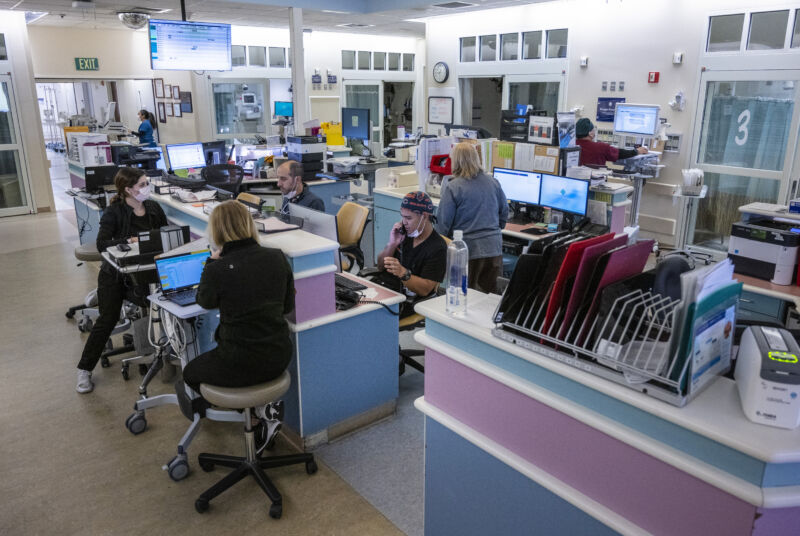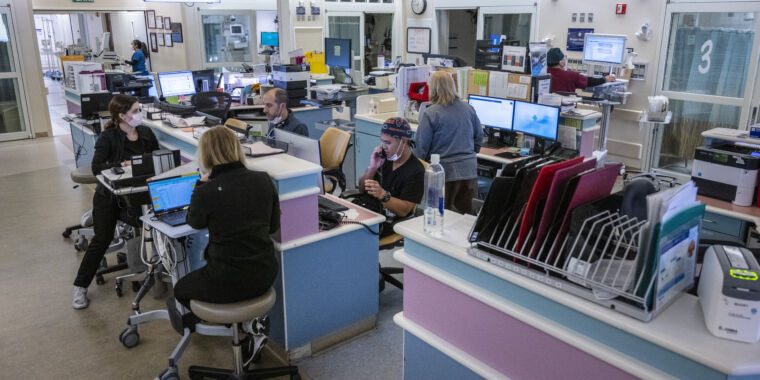
The charge nurse who called 911 last month when her emergency department became overwhelmed with patients is speaking candidly about the chaos, fear, and unsafe conditions that continue to plague her hospital and others around the country.
Kelsay Irby, the ER charge nurse at St. Michael’s Medical Center in the greater Seattle area, penned an eye-opening essay for Nurse.org Tuesday, offering context, commentary, and more details around the infamous night of October 8.
That evening, the hospital’s emergency department was “even more short-staffed than normal, operating at less than 50 percent of our ideal staffing grid,” Irby said, and there were around 50 people in the waiting room. The nurses were becoming increasingly nervous that some of the people stuck waiting in the lobby had cardiac and respiratory problems, and there were also children with very high fevers. With only one nurse available to keep an eye on people waiting, they could be “unmonitored for extended periods of time.”
The situation was “extremely difficult,” Irby said. “I have never heard so many nurses say, ‘I am in serious fear for my license.'” That’s when, after exhausting all other options, she made the bold choice to call emergency services. The local fire chief sent a crew who stayed in the emergency department to help monitor patients, take vitals, and make sure the patient list was accurately updated.
The area’s fire chief, Jay Christian, later praised his crew and Irby for their actions that night, telling local newspaper Kitsap Sun: “I think about the courage of that nurse to reach out and call for help,” Christian said. “I think about the firefighters who had to respond in that uncertain situation. I’m really proud of those individuals, and what they were able to do to resolve that crisis that night.”
Business as usual
But the crisis isn’t over, Irby noted in her essay, and she wants to use the momentum from that night to “spearhead a long overdue dialogue on the issues facing healthcare as a whole, but my hospital in particular.”
She spoke of long-standing understaffing and management turnover that has led to a constant state of chaos. Then, days before the crisis on October 8, the hospital was struck by a cyberattack that knocked out its electronic medical record system, leaving nurses to track patients with paper charts. Irby wrote:
I cannot overstate how chaotic it was. Labs got lost, orders got lost, and patients got lost in the back and forth to exam rooms, imaging, and other assessment areas. Doctors were frustrated, nurses were frazzled, and wait times climbed as high as 12 hours, unheard of in our hospital. We were in full crisis mode, yet our senior management continued to tell the public that we had a well-developed plan in place and that we were ‘business as usual.’
Cyberattacks against US hospitals have been increasing since 2018. Though hospital systems don’t always publicize when they’ve been attacked, cybersecurity company Recorded Future told NBC News in September that there were 297 known attacks just last year. Because many hospital systems are conglomerates, one attack can knock out many facilities at once. This year, for instance, 12 attacks have affected 56 different facilities.
Understaffing
Understaffing is also a long-standing and pervasive problem that Irby emphasized many times in her essay.
“I see, behind the scenes, the fatigue and moral distress that is caused by working in a state of chronic crisis staffing levels, for a corporation that seems completely out of touch and apathetic to what is really happening in their beautiful new hospital,” Irby said. She highlighted that many experienced nurses have left, while younger, less-experienced nurses take on roles they may not be ready for, increasing the risks of burnout. Travel nurses, meanwhile, will break contracts and risk tarnishing their reputations in the travel community to get out of facilities where conditions are so chaotic they fear it could endanger their licenses.
A recent national survey of nurses by staffing agency ConnectRN found that 90 percent of nurses say understaffing is harming patient care. Half of nurses also said they have considered leaving the profession, with the top reasons being understaffing (61 percent), poor work/life balance (58 percent), and burnout (56 percent).
In response to Irby’s essay and concerns about understaffing, St. Michael’s Medical Center told Nurse.org that “Turnover at St. Michael for healthcare staff is well under the national average, and RN turnover at St. Michael is lower today than it was throughout COVID-19. We believe this is a testament to our ongoing efforts to recruit and retain staff, as we actively hire for full-time, part-time and as-needed employees.” It added that it is also using “innovative ways to attract and retain team members,” such as sign-on bonuses, and is working to build recruitment pipelines from area nursing and medical programs.








